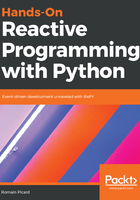
The merge operator
The merge operator combines several observables into a single observable by merging all items emitted by the source observables in its output observable. The merge operator accepts several observables as input and returns one output observable:

The items emitted by each source observable are interleaved on the output observable. As shown in the Figure 3.7, the output observable completes once all input observables have completed. However, if a source observable completes on error then the output observable immediately completes on error:

The prototype of the merge operator is the following one:
Observable.merge(self, *args)
Observable.merge(*args)
This method can be used as a method of an Observable object, or as a static method of the Observable class. The arguments passed as input can be several observables to merge, or a list containing the observables to merge:
numbers = Observable.from_([1, 2, 3, 4])
strings = Observable.from_(["one", "two", "three", "four"])
print("Merge from object method:")
numbers.merge(strings) \
.subscribe(
on_next=lambda i: print("item: {}".format(i)),
on_error=lambda e: print("error: {}".format(e)),
on_completed=lambda: print("completed")
)
print("Merge from class static method:")
Observable.merge([numbers, strings]) \
.subscribe(
on_next=lambda i: print("item: {}".format(i)),
on_error=lambda e: print("error: {}".format(e)),
on_completed=lambda: print("completed")
)